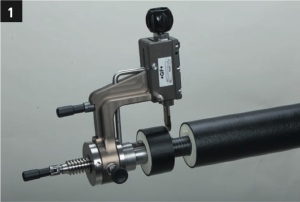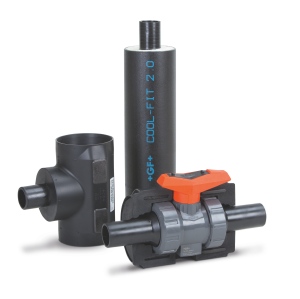Rethinking pipework for chilled-water air conditioning
George Fischer has 60 years’ experience in plastic piping systems — and continues to innovate. Its approach to chilled water for air conditioning caught the attention of Ken Sharpe.
 |
| The features of Cool-fit 2.0. |
Following the success of its Cool-Fit pre-insulated plastic pipework concept for refrigeration systems, George Fischer has developed a version for chilled water. Described as ‘the revolution for efficient cooling’, it is targeted at the air-conditioning and the rapidly growing data-centre market.
Let us put the benefits of pre-insulated plastic pipework for transporting cold liquids into perspective with the help of Mark Bulmer, global market segment manager for cooling.
He paints a picture of how all is not well in transporting cooling for refrigeration — with installations having condensation dripping from pipework, mould growing on pipes and ice build-up when the liquid being carried is below 0°C.
The problems arise because of the difficulty of adding insulation and vapour barriers to pipes in situ. He explains, ‘Installers are trying to insulate a piping system that is above their heads in very awkward situations.’
That scenario prompted George Fischer to draw on its experience with pre-insulated plastic pipework for below-ground applications. That first generation of Cool-Fit comprises an ABS inner pipe and associated fittings Not only is the system pre-insulated, but is also water and vapour tight.
The Cool-Fit concept has many features that are attractive for transporting chilled water for comfort-cooling. However, its 36 mm of insulation make it too bulky for such applications, where the temperature of the water is much higher. A different product was needed to address the special requirements of comfort cooling.
‘That led to a 5-year project to develop Cool-fit 2.0.
 |
| This special tool is the key to preparing lengths of pipework for jointing using George Fischer’s electrofusion technique. |
Whereas the installer of a chilled-water system is normally confronted with pipes that need jointing, insulating, taping up to provide a vapour barrier to prevent condensation making the insulation wet and ineffective, a Cool-fit 2 .0 installation requires just Cool-fit 2.0 pipes, fittings and valves.
The pipe itself comprises the inner pipe, high-performance insulation and a very robust outer jacket as a one-piece construction that automatically provides a vapour barrier. There are seven sizes of pipe with internal diameters from 32 to 110 mm. They come in lengths of 5 m.
Preparing a length of pipe for jointing is achieved with a special tool that removes the outer jacket and insulation, leaving a short length of the inner pipe to insert into the joint. The ends of pipes as delivered are already prepared.
Jointing is carried out by George Fischer’s electrofusion process, which typically takes less than 50 s.
So what about restoring the integrity of the vapour barrier?
‘No need,’ says Daniel Dossenbach. ‘All the connections and fittings have a soft-lip where the pipe is inserted and which achieves a vapour-tight connection around the outer jacket.’
And what about the openings for the electrical connections for the electrofusion jointing process?
‘Just seal the welding connections with the attached insulation plugs,’ says Daniel Dossenbach.
And supporting the pipework?
The outer jacket is rigid, so ordinary pipe-support brackets can be used without fear of compromising the integrity of the insulation or the vapour barrier.
Cool-fit 2.0 is said to be more energy efficient than other metal piping systems (copper, carbon steel and stainless steel) insulated after installation with rubber-based foam — 35% on average.
 |
| Designed for chilled-water air conditioning — George Fischer’s Cool-fit 2.0 system. |
An implication of this improved efficiency is that the temperature of chilled water off the chiller could be raised without compromising the flow temperature reaching terminal units such as fan-coil units or chilled beams. Likewise, less heat will be picked up by the return water, so the chiller has less work to do reducing the temperature of the return water to the desired flow temperature.
An entry for the 2016 awards of the Building Controls Industry Association shows just how much effect a small difference in flow temperature can have on the energy used by the chiller and associated pumps.
The project involved replacing chillers at Standard Life House in London, for which RSP Consulting Engineers was the consultant. Running the chiller at a 1 K higher flow temperature over a 3-month period reduced electricity consumption by 30% compared with the same period the previous year. The client commented on ‘what can be achieved when specialists are afforded the time and opportunity to properly commission buildings’.
And finally, for those concerned about the carbon footprint of a project, George Fischer has some figures.
The example is a 3-storey building with 123 offices. It would need a piping system nearly 3000 m long to convey chilled water for the air conditioning.
Using copper for such a system equates to 17.5 to of CO2 compared to just 5 t using Cool-fit 2.0.
Can we expect Cool-fit 2.0 to feature in award schemes soon?








